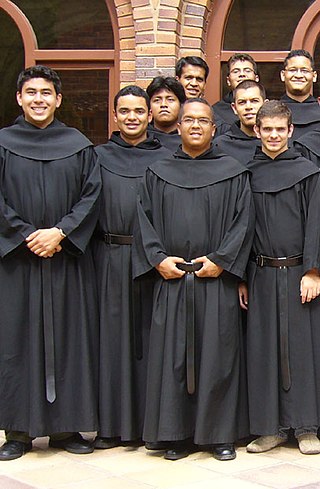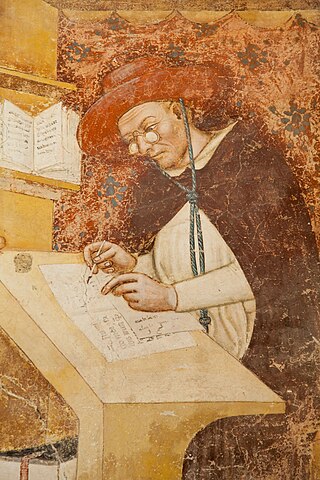Related Research Articles
The Benedictines, officially the Order of Saint Benedict, are a mainly contemplative monastic religious order of the Catholic Church for men and for women who follow the Rule of Saint Benedict. The male religious are also sometimes called the Black Monks, in reference to the colour of their religious habits, pace the Olivetans who wear white. They were founded in 529 by Benedict of Nursia, a 6th-century Italian monk who laid the foundations of Benedictine monasticism through the formulation of his Rule. Benedict's sister, Scholastica, possibly his twin, also became a religious from an early age, but chose to live as a hermit. They retained a close relationship until her death.

The Order of Preachers, also known as the Dominican Order, is a Roman Catholic mendicant order of pontifical right that was founded in France by a Castilian priest named Dominic de Guzmán. It was approved by Pope Honorius III via the papal bull Religiosam vitam on 22 December 1216. Members of the order, who are referred to as Dominicans, generally display the letters OP after their names, standing for Ordinis Praedicatorum, meaning 'of the Order of Preachers'. Membership in the order includes friars, nuns, active sisters, and lay or secular Dominicans. More recently, there has been a growing number of associates of the religious sisters who are unrelated to the tertiaries.

Pope Benedict XI, born Nicola Boccasini, was head of the Catholic Church and ruler of the Papal States from 22 October 1303 to his death, in 7 July 1304.

The Order of the Brothers of the Blessed Virgin Mary of Mount Carmel, known as the Carmelites or sometimes by synecdoche known simply as Carmel, is a Roman Catholic mendicant religious order for men and women. Historical records about its origin remain uncertain, but it was probably founded in the 12th century on Mount Carmel in the Crusader States. Berthold of Calabria, as well as Albert of Vercelli, have traditionally been associated with the founding of the order, but few clear records of early Carmelite history have survived. The order of Carmelite nuns was formalised in 1452.

The Franciscans are a group of related mendicant Christian religious orders within the Catholic Church. Founded in 1209 by the Italian saint Francis of Assisi, these orders include three independent orders for men, orders for nuns such as the Order of Saint Clare, and the Third Order of Saint Francis open to male and female members. They adhere to the teachings and spiritual disciplines of the founder and of his main associates and followers, such as Clare of Assisi, Anthony of Padua, and Elizabeth of Hungary. Several smaller Protestant Franciscan orders exist as well, notably in the Anglican and Lutheran traditions.

A convent is a community of monks, nuns, friars or religious sisters. Alternatively, convent means the building used by the community. The word is particularly used in the Catholic Church, Lutheran churches, and the Anglican Communion.

Augustinians are members of Christian religious orders that follow the Rule of Saint Augustine, written in about 400 AD by Augustine of Hippo. There are two distinct types of Augustinians in Catholic religious orders dating back to the 12th–13th centuries:

A friar is a member of one of the mendicant orders founded in the twelfth or thirteenth century; the term distinguishes the mendicants' itinerant apostolic character, exercised broadly under the jurisdiction of a superior general, from the older monastic orders' allegiance to a single monastery formalized by their vow of stability. A friar may be in holy orders or be a brother. The most significant orders of friars are the Dominicans, Franciscans, Augustinians, and Carmelites.

The Trappists, officially known as the Order of Cistercians of the Strict Observance and originally named the Order of Reformed Cistercians of Our Lady of La Trappe, are a Catholic religious order of cloistered monastics that branched off from the Cistercians. They follow the Rule of Saint Benedict and have communities of both monks and nuns that are known as Trappists and Trappistines, respectively. They are named after La Trappe Abbey, the monastery from which the movement and religious order originated. The movement first began with the reforms that Abbot Armand Jean le Bouthillier de Rancé introduced in 1664, later leading to the creation of Trappist congregations, and eventually the formal constitution as a separate religious order in 1892.

In the Catholic Church, a religious order is a community of consecrated life with members that profess solemn vows. They are classed as a type of religious institute.

The Servite Order, officially known as the Order of Servants of Mary, is one of the five original mendicant orders in the Roman Catholic Church. It includes several branches of friars, contemplative nuns, a congregation of religious sisters, and lay groups. The order's objectives are the sanctification of its members, the preaching of the Gospel, and the propagation of devotion to the Mother of God, with special reference to her sorrows. The Servites friars lead a community life in the tradition of the mendicant orders.

Mendicant orders are, primarily, certain Roman Catholic religious orders that have adopted for their male members a lifestyle of poverty, traveling, and living in urban areas for purposes of preaching, evangelization, and ministry, especially to the poor. At their foundation these orders rejected the previously established monastic model. This model prescribed living in one stable, isolated community where members worked at a trade and owned property in common, including land, buildings and other wealth. By contrast, the mendicants avoided owning property at all, did not work at a trade, and embraced a poor, often itinerant lifestyle. They depended for their survival on the goodwill of the people to whom they preached. The members of these orders are not called monks but friars.

Hugh of Saint-Cher, O.P. was a French Dominican friar who became a cardinal and noted biblical commentator.

Henry Suso, OP was a German Dominican friar and the most popular vernacular writer of the fourteenth century. Suso is thought to have been born on 21 March 1295. An important author in both Latin and Middle High German, he is also notable for defending Meister Eckhart's legacy after Eckhart was posthumously condemned for heresy in 1329. He died in Ulm on 25 January 1366, and was beatified by the Catholic Church in 1831.
Canons regular are priests who live in community under a rule and are generally organised into religious orders, differing from both secular canons and other forms of religious life, such as clerics regular, designated by a partly similar terminology.

Cluny Abbey is a former Benedictine monastery in Cluny, Saône-et-Loire, France. It was dedicated to Saint Peter.

The Dominican Rite is the unique liturgical rite of the Dominican Order in the Catholic Church. It has been classified differently by different sources – some consider it a usage of the Roman Rite, others a variant of the Gallican Rite, and still others a form of the Roman Rite into which Gallican elements were inserted.
Prior is an ecclesiastical title for a superior in some religious orders. The word is derived from the Latin for "earlier" or "first". Its earlier generic usage referred to any monastic superior. In abbeys, a prior would be lower in rank than the abbey's abbot or abbess.
Gyrovagues were wandering or itinerant monks without fixed residence or leadership, who relied on charity and the hospitality of others.
"A religious institute is a society in which members, according to proper law, pronounce public vows, either perpetual or temporary which are to be renewed, however, when the period of time has elapsed, and lead a life of brothers or sisters in common."
References
- ↑ Hugh or Hugues de Vaucemain.
- ↑ "Maestros de la Orden". Archived from the original on 2007-11-01. Retrieved 2007-10-02., Spanish language.
- ↑ Ashley/Dominicans: 3 Mystics 1300s Archived 2008-07-25 at the Wayback Machine
- ↑ CATHOLIC ENCYCLOPEDIA: Order of Preachers